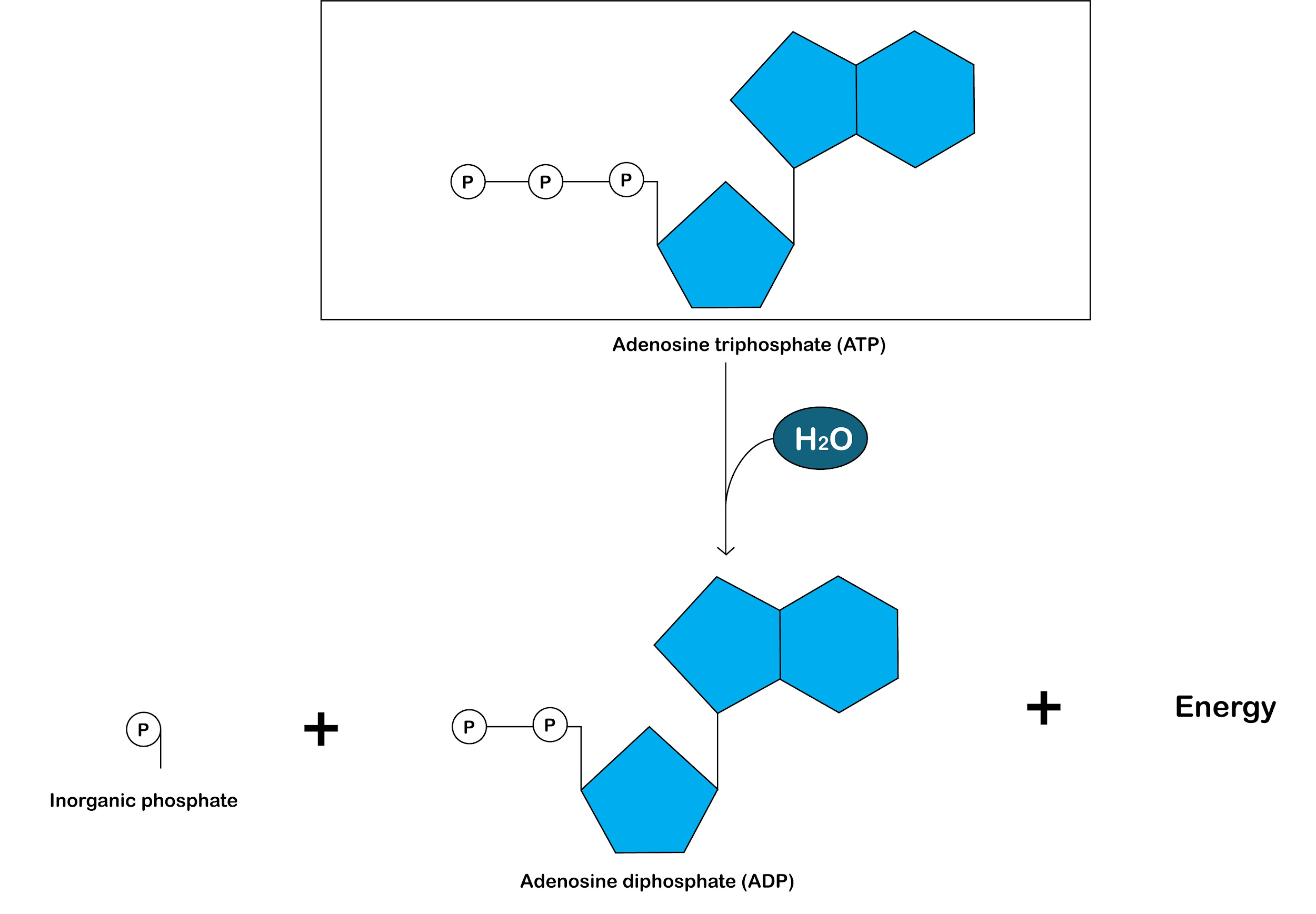
Answer
444.3k+ views
Hint: One adenosine and three (tri) phosphate groups are composed of an ATP molecule. Adenosine diphosphate (ADP), which is the remaining adenosine and two (di) phosphate groups, and one single 'alone' phosphate (Pi) are the by-products of ATP breakdown.
Complete answer:
The energy currency of life is adenosine triphosphate (ATP). The energy produced in mitochondria is stored in the form of ATP during cellular respiration. Via its separation into ADP and Pi, it provides energy for all life activities. ATP comprises three classes of phosphates that have a high energy bond. Energy is released from ATP hydrolysis and ADP is formed. This reaction is generally referred to as the hydrolysis of ATP because the basic reaction requires a water molecule,
ATP+Water\longrightarrow ADP+Pi
Additional Information: ADP stands for adenosine diphosphate, and not only is it one of the body's most important molecules, but it is also one of the most numerous. ADP is an ingredient for DNA, it is important for muscle contraction, and when a blood vessel is broken, it also helps initiate healing.
A cofactor essential to metabolism is the nicotinamide adenine dinucleotide. NAD is considered a dinucleotide present in all living cells because it consists of two nucleotides connected by their phosphate groups. The adenine nucleobase and the other nicotinamide contain one nucleotide.
So, the correct answer is ‘Splits into a phosphate ion and ADP’.
Note: The nucleotide known in biochemistry as the "molecular currency" of intracellular energy transfer is the adenosine triphosphate (ATP) molecule; that is to say, ATP can store and transport chemical energy within cells. In the synthesis of nucleic acids, ATP also has a significant role.

Complete answer:
The energy currency of life is adenosine triphosphate (ATP). The energy produced in mitochondria is stored in the form of ATP during cellular respiration. Via its separation into ADP and Pi, it provides energy for all life activities. ATP comprises three classes of phosphates that have a high energy bond. Energy is released from ATP hydrolysis and ADP is formed. This reaction is generally referred to as the hydrolysis of ATP because the basic reaction requires a water molecule,
ATP+Water\longrightarrow ADP+Pi
Additional Information: ADP stands for adenosine diphosphate, and not only is it one of the body's most important molecules, but it is also one of the most numerous. ADP is an ingredient for DNA, it is important for muscle contraction, and when a blood vessel is broken, it also helps initiate healing.
A cofactor essential to metabolism is the nicotinamide adenine dinucleotide. NAD is considered a dinucleotide present in all living cells because it consists of two nucleotides connected by their phosphate groups. The adenine nucleobase and the other nicotinamide contain one nucleotide.
So, the correct answer is ‘Splits into a phosphate ion and ADP’.
Note: The nucleotide known in biochemistry as the "molecular currency" of intracellular energy transfer is the adenosine triphosphate (ATP) molecule; that is to say, ATP can store and transport chemical energy within cells. In the synthesis of nucleic acids, ATP also has a significant role.

Recently Updated Pages
Who among the following was the religious guru of class 7 social science CBSE

what is the correct chronological order of the following class 10 social science CBSE

Which of the following was not the actual cause for class 10 social science CBSE

Which of the following statements is not correct A class 10 social science CBSE

Which of the following leaders was not present in the class 10 social science CBSE

Garampani Sanctuary is located at A Diphu Assam B Gangtok class 10 social science CBSE

Trending doubts
Which are the Top 10 Largest Countries of the World?

A rainbow has circular shape because A The earth is class 11 physics CBSE

Fill the blanks with the suitable prepositions 1 The class 9 english CBSE

How do you graph the function fx 4x class 9 maths CBSE

Give 10 examples for herbs , shrubs , climbers , creepers

In Indian rupees 1 trillion is equal to how many c class 8 maths CBSE

The Equation xxx + 2 is Satisfied when x is Equal to Class 10 Maths

Difference between Prokaryotic cell and Eukaryotic class 11 biology CBSE

What is BLO What is the full form of BLO class 8 social science CBSE




